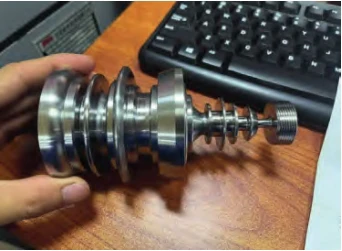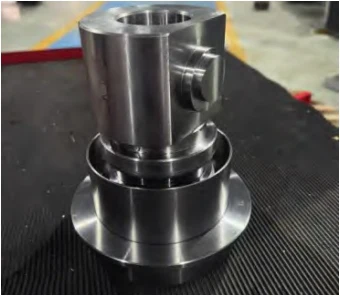China’s manufacturing is rapidly developing, with CNC machining at its core; machining accuracy directly affects product performance and quality.
Size deviation and low positioning accuracy harm part quality, efficiency, and sustainable high-precision manufacturing.
This paper analyzes accuracy factors, proposes solutions, and develops high-precision CNC methods for production.
Precision problems in CNC machining
CNC precision affects quality and productivity but faces issues like size, shape, and positioning errors.
- The difference in dimensional accuracy is too large.
Workpiece size deviates from design mainly due to machine tool precision, tool wear, fixture issues, or program errors.
- The shape and position accuracy is not up to standard.
Unreasonable tool paths, processes, and mechanical dynamics degrade workpiece quality and shorten service life.
- Substandard positioning accuracy.
Fixture errors and thermal deformation seriously affect workpiece positional accuracy and reduce assembly stability.
CNC machining accuracy problems caused by analysis
Machine body error
Machine tool body error is the main factor affecting the accuracy of CNC machining.
First, 40%-60% of the geometric error in machine tool processing, guideway straightness error of ± 5.00 µm / m, ball screw backlash 3.00-10.00 µm.
Secondly, in terms of thermal deformation error, when the spindle temperature rises by 1 °C, its radial movement will reach 2.00-3.00 µm.
Use infrared cameras to monitor equipment temperature in real time, enabling timely preventive measures.
Thirdly, spindle radial error must stay below 2.00 µm and system response within ±1.000 mm; exceeding these reduces part surface quality.
Process system error
Process system errors, shown by fixture loss and errors, significantly affect CNC machine accuracy.
Fixture wear over 0.3 mm cuts workpiece surface roughness by 50%, damaging quality.
Fixture errors require positioning pin repeatability within 5 μm to prevent workpiece positioning errors.
Programming and Operation Errors
Programming and operation errors mainly affect CNC accuracy through toolpath planning and cutting parameter settings (Figure 1).

First, reasonable tool path planning improves workpiece processing quality.
A comparison of spiral and step-by-step milling yields a new method to reduce abrasion marks and surface roughness.
Inappropriate cutting parameters affect machining process stability.
Higher cutting rates increase force, accelerating tool wear, causing vibration, and reducing accuracy and surface quality.
Environmental factors
In CNC machining, temperature fluctuations are the most significant environmental factor.
Results show that rising workshop temperature causes thermal expansion and deformation of the machine tool (Figure 2).
Each 1 °C rise causes a 5.75 µm deviation in a 500 mm machine, lowering accuracy.
This problem is particularly acute when machining larger parts. Fig. 2 Analysis of machine body error for large metal parts

Solutions for improving CNC machining accuracy
Compensation technology for machine tool body error
Machine tool error compensation, using real-time precision testing, is key to improving CNC machining accuracy.
High-precision testing and laser interferometry detect errors and feed corrections to CNC for real-time compensation, enhancing positioning accuracy.
Accurate forecasting and error correction enable thermal error compensation for heat and external temperature.
Collect temperature and deformation data during machining to build a BP neural network model of thermal deformation.
PE predicts and auto-compensates thermal deviations via real-time monitoring, enhancing CNC stability.
Combining intelligent sensing and IoT enables multi-sensor fusion to improve CNC accuracy.
Optimization measures for process system errors
Improving cutting parameters, tool paths, and process strategies enhances CNC machining quality and efficiency.
Intelligent algorithms optimize cutting parameters, boosting accuracy and efficiency while reducing cost and time.
Adaptive cutting technology addresses various problems in cutting processes.
The system uses real-time testing and CNC to monitor cutting forces and vibrations, adjusting feed rate accordingly.
This technology cuts vibration and tool wear, enhancing stability, quality, productivity, and costs—especially for complex or light machining.
Combine workpiece material, size, and requirements to optimize machining and enhance CNC accuracy and efficiency.
Improvement methods for programming and operating errors
Intelligent tool path planning and parameter optimization reduce CNC programming and operating errors to improve accuracy.
Simulation software optimizes tool paths; 3D modeling aids accurate visualization and trace identification.
Manual or software toolpath optimization reduces errors and improves workpiece surface smoothness.
Engineers build a database using data and mathematical models with objectives and constraints.
After optimization, engineers obtain the best parameters to boost productivity.
Control strategy for environmental factors
Large temperature changes during CNC machining reduce dimensional stability and accuracy.
To avoid this, engineers control workshop temperature within ±0.5 ℃.
Engineers install HVAC with sensors to monitor and adjust workshop temperature.
Downward and upward air supply stabilizes flow, cuts temperature differences, and boosts machining accuracy.
CNC spindle motors and servo systems generate heat during operation, causing temperature changes that affect machining accuracy.
Technicians install water- or air-cooled systems to dissipate heat from hot CNC parts.
Engineers use double-layer insulation and low-e glass to reduce outdoor temperature effects on the workshop.
Technicians add insulation or cooling to high-temperature equipment to prevent heat buildup and stabilize temperature.
CNC temperature systems use sensors for real-time data; ±0.3 °C fluctuation triggers alarms and cooling.
Validation and effect evaluation
Engineers machine 7075-T6 aluminum parts using traditional and new methods.
- Traditional methods. The selected equipment is a model of five-axis CNC machining center with a positioning accuracy of ±5.00 μm.
Operators follow factory processes using ap = 1 mm, fz = 0.15 mm/z, and vc = 150 m/min with carbide tools and no error compensation.
- New method predicts thermal errors with BP neural network, optimizes parameters, and uses diamond tools.
Engineers maintain constant temperature control (±0.5 °C); after processing, they measure key dimensions and surface roughness (Ra).
- Experimental results show key hole distance error improved 40%, from ±0.020 mm to ±0.012 mm.
The surface roughness Ra value is optimized from 1.20 μm to 0.78 μm, a reduction of 35%; the scrap rate is greatly reduced from 5% to 1.2%.
Analysis shows error compensation reduces thermal drift, optimized parameters cut vibration, and diamond tools ensure machining consistency.
Conclusion
Improving CNC precision and quality requires timely control of multiple factors in a complex system.
Engineers improve CNC precision and stability through error compensation, process optimization, high-precision tools, and intelligent control.
